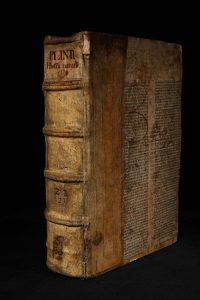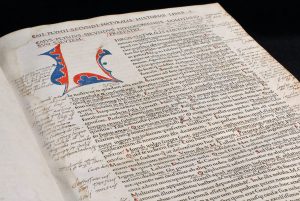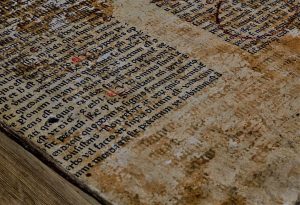

Since my earlier post on the subject of earlier books turning up in (or on) later ones, I’ve discovered many other examples of early modern recycling at work. I wanted to share one more example of “book covering” in the opposite direction, where the recycled leaves from earlier materials are still present. This example comes from another book printed before 1500, albeit one written by a much earlier author. Sometime after 70 CE, the Roman naval commander Pliny the Elder (23-79 CE) penned a compendious volume known as the Natural History, whose thirty-seven books covered the breadth of what Pliny was able to examine or record about the natural world.
Pliny’s empiricism was near boundless, and over a thousand years after it was written, his reputation as an authority during the Middle Ages made the Natural History a sought-after reference work for renaissance humanists. This edition, produced in Venice 1472, represented a massive undertaking on the part of its emigrée printer, the French engraver Nicolaus Jenson, who had learned the techniques of printing with movable type at its source in Mainz around a decade earlier. After the work left the press, the work of applying color (and order) to the pages fell to a team of scribes who painstakingly inserted the hundreds of initials, underlines, and symbols that gave the volume its punctuation. A note in the back of the book informs us that this was finished in 1474.

Finally, the copy would have needed to be bound. Unlike before, the recycled leaves have been left on this binding, allowing us to see that this printed book is covered in another printed book. Unfortunately this fragment is a bit harder to identify, but from the section on the back cover it looks like we have a fine-grained discussion of lying (the heading reads “On hypocrisy and dissimulation) taken or adapted from another encyclopedic work, Thomas Aquinas’ Summa Theologiae. But that’s not all! Underneath that printed text, we can make out the outlines of earlier handwriting, again upside down, that had been scraped off the parchment beforehand. The outlines of the bold medieval bookhand (generally referred to as textura) gives an idea of what most early printers were trying to imitate with their types.

Printing on vellum was a tricky exercise, since printer’s ink could tend to smear off of the less-absorbent material and ruin the pages being printed. So while it was a point of pride for early printers (not to mention a luxury feature for discerning bookbuyers) to offer both options, it likely produced a lot of waste. Yet not only was a fifteenth-century printer willing to go through the effort of scraping the original parchment to print on it, after the leaf was ruined, a sixteenth-century binder said, “I can still use that.” Even though it looks (and is!) old, this recycled binding is, in fact, not the first cover that this copy of Pliny’s work would have had. The boards that our re-purposed leaves are covering are not wood, but pasteboard (another recycled product), but the most obvious clue is hiding at the top of the page, where a series of running headings put in by the rubricators (telling the reader what part of the book they had opened to) have been almost entirely removed. This would have been done when the book was being trimmed down to fit in its new binding, and we are left to imagine how large this book would have been when it came off the press! So there you have it, a book covering a book covering several books in one, and a sense of how valuable the materials for bookmaking could be. Well into the 1600s, long after the leaves of both these books were printed, binders were still employing the same techniques to cover and repair books. The premodern drive to recycle old materials for books didn’t stop with manuscript leaves. It was widely practiced in all aspects of bookmaking, to the extent that it even inspired allegorical poetry. Given that most paper was made not from wood pulp but from scraps of linen or cloth, John Taylor’s 1620 poem The praise of hemp-seed gives us a literal example of “rags to riches.” (Professor Adam Smyth gave a wonderful talk this past spring on the poem and the topic, a fuller version is available in his recently published book, Material Texts in Early Modern England).
May not the Linen of a Tyburn slave,
More honour then a mighty Monarke have?
That though he dyed a Traytor most disloyall,
His Shirt may be transform’d to Paper royall.
And may not dirty Socks, from off the feet
From thence be turnd to a Crowne-paper sheet?
Tyburn, in the verse above, was the site of a gallows in Taylor’s time, and his pun on the most expensive and highest quality papers available (Crown paper and paper royal) provides a pointed social allegory – The king’s rich robes, in later lines, become the most ordinary sort of paper Taylor can think of. While not strictly advertised as such, I think it’s safe to say that we’re not the only generation interested in the value of reclaimed and repurposed materials. The many artisans and readers who made use volumes like this one all found continued relevance in both the text and the material of the books they used.
